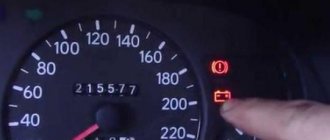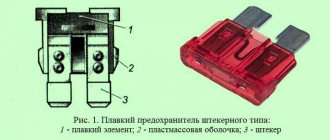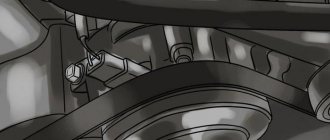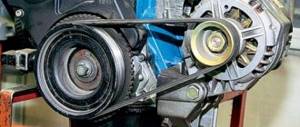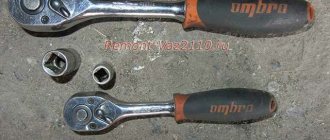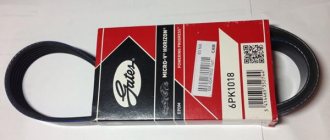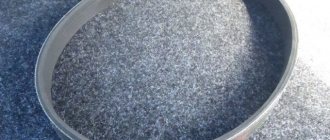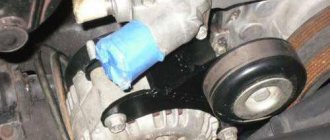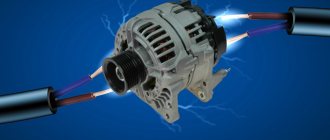A freewheel, otherwise known as an overrunning clutch, is one of the important components of automobile alternators designed to prevent the transfer of torque to the drive shaft in cases where the rotation speed of the driven shaft becomes too high. In addition, this clutch comes into operation when torque needs to be transmitted in one direction. About the design of the freewheel, its malfunctions and the method of selecting a new part - in the material Avto.pro.
A little about the operation of the generator
First, it’s worth studying the question of how a car generator works. If you want to seriously understand the structure of this unit, then you should study thematic materials - it’s quite interesting. Now we will look at some aspects of the generator’s operation and try to understand its structure. In general, car generators consist of many elements, but its main components include the following:
- Pulley;
- Frame;
- Rotor (rotating part of the generator);
- Stator (fixed part of the generator);
- Diode module;
- Diode module protection;
- Voltage regulator;
- Brush unit.
The operation of this unit is based on the effect of electromagnetic induction. Its essence is that a magnetic flux passes through a coil of, for example, copper wire. When the value of the magnetic flux changes, an electrical voltage appears at the terminals of that same coil. The voltage values are proportional to the speed at which the magnetic flux . In turn, for a flow to occur, a current must be passed through the coil. To summarize : the rotor (the rotating part of the generator) acts as a source of alternating magnetic field, and the source of electrical flux is the stator.
As soon as the driver turns the ignition key, current is supplied to the generator field winding. A magnetic field is induced in the winding, causing the rotor to move. Afterwards, the crankshaft begins to rotate. For a generator to produce electrical energy, its shaft must continue to rotate. It receives revolutions from the crankshaft, to which it is connected by a belt drive . And now the last point: power receivers are powered by direct current, while the generator produces alternating current. To solve this problem, the generator has a rectifier unit. To control the output parameters, a voltage regulator is also included in the generator design.
Why do you need an overrunning clutch?
One of the weakest points of generators is the belt drive. Not so long ago, generator belts lasted for at most 30 thousand kilometers - after such a mileage they were almost guaranteed to break. The problem is that the car’s engine operates unevenly - torque is transmitted through the shaft in pulses, the order of which corresponds to the combustion of fuel in the cylinders. In turn, the rotor speed should be 2-3 times higher than the crankshaft speed. Add to this the fact that the car constantly changes speed (acceleration and braking), and imagine how over time the alternator belt stretches and then breaks. This effect was mitigated by introducing an overrunning clutch connected to the generator pulley. Its main elements:
- Inner race connected to the rotor;
- The outer race facing the pulley.
The overrunning clutch works in the same way as the starter bendix, which we wrote about in this material. When the rotor shaft begins to accelerate too much during the combustion of the fuel-air mixture in the internal combustion engine cylinders, the locking rollers close the clutch races, which allows the entire torque . When the mixture does not burn and the crankshaft slows down a little, the rotation speed of the outer race begins to “lag behind” the speed of the inner race. Essentially, at this moment the clips are disconnected. In this case, the pulley and rotor rotate separately from each other, which makes it possible to neutralize the negative effect of the difference in rotation speeds.
Generator overrunning clutch - operating principle
Just 15–20 years ago, alternator belts lasted no more than 25–30 thousand kilometers, after which they had to be replaced due to inevitable rupture. Such a short service life of the belts is due to the uneven functioning of the car engine, the torque from which is transmitted in impulses during the combustion of fuel in the cylinders.
For two full revolutions of the crankshaft, this process is carried out once, which causes an inconsistent crankshaft rotation rate. In this case, the parts driven by the generator belt rotate by inertia with a different cyclicity than the shaft (they either lead it or lag significantly behind it). If we add to the described phenomenon the modes of accelerating the car and braking it, starting and stopping the engine, you can understand why the belt stretches and then (after some time) breaks.
To neutralize this negative fact, an overrunning clutch was created, which was simply built into the generator pulley. It has two clips:
- internal, connected to the generator armature shaft;
- external, which connects directly to the pulley.
The principle of operation of this unit is similar to the principle by which the starter bendix works. When the armature accelerates during fuel combustion in the cylinders, special locking rollers close the two parts of the clutch cage with each other, and torque is supplied to the armature. And when the fuel does not burn (rotation of the crankshaft slows down due to fuel compression), the outer race begins to “lag behind” the inner race. This leads to the separation of the clips, which means that the rotation of the armature and the pulley becomes independent, which ensures that there is no negative impact of inertia on the generator belt.
More about the device
Now let's look at the overrunning clutch device in detail. Despite the fact that its circuit may seem quite simple, it is a complex device in its own way, each element in which is clearly adjusted to the adjacent one and performs its role. So, here's what a car alternator overrunning clutch includes:
- An outer ring with special grooves on the inner surface;
- A series of springs on the outer ring pushing out the rollers;
- Inner ring;
- Rollers that transmit torque when the cages are closed.
There are also ratchet clutches that have unidirectional teeth on the inner surface instead of slots with rollers. As with the more common roller clutches, ratchets have a pawl that is pressed against the outer ring by spring force, thereby locking the races and allowing them to rotate at the same speed . As you might guess, such couplings work automatically - exclusively mechanical elements are responsible for closing the rings, which provides the entire device not only with high performance, but also with high wear resistance.
What does an overrunning clutch consist of?
Today, overrunning clutches come in two versions: roller or ratchet. A simple roller freewheel includes components such as outer and inner races, located on the outer spring race, and rollers that transmit the corresponding torque. Instead of puzzles, the roller clutch has teeth on the inner surface that have a stop on one side. Both rings are jammed by a special pawl, which is pressed against the outer ring by a spring. The advantages of such an overrunning clutch are that it ensures automatic switching on and off of the mechanism. In it, the designs of components and assemblies are significantly simplified due to freewheel mechanisms. And the design of the coupling itself is very simple and understandable.
What else is worth knowing about overrunning clutches?
Despite their simple design, generator couplings have a number of disadvantages. It’s worth saying right away that couplings with roller and ratchet mechanisms have their weak points. First, let's talk about roller clutches. As already mentioned, they have grooves with ejector rollers. This imposes some restrictions:
- The mechanism cannot be adjusted;
- It requires strict alignment of the shafts;
- It is quite difficult to manufacture - the geometry of each element must be observed.
A simpler, as at first glance, ratchet overrunning clutch should have more serious disadvantages. Among them:
- Possibility of impacts when the pawl engages the teeth. This imposes restrictions - such a mechanism cannot be used in units rotating at high speed;
- Increased operating noise. Today, couplings are made with pawls that move clockwise and do not touch the ratchet wheel, but most couplings still have a noisy design;
- The teeth wear out over time.
Practice has shown that clutches with a ratcheting mechanism have proven to be more reliable than their roller counterparts. What is also important is that ratchet clutches are repairable. Trying to repair devices with rollers will not yield anything, since the device itself is non-separable. Even despite all the listed disadvantages, couplings of both types are distinguished by decent service life and high reliability. On average, their resource in kilometers is 100 thousand km . At the same time, the coupling really increases the service life of the entire belt drive. Replacing it is much cheaper than buying a high-quality belt, rollers and tensioner. Some experts say that a belt drive with a drive mechanism lasts 5-6 times longer than a drive without this mechanism. It is also generally quieter.
Signs of a faulty freewheel
Spare parts for Renault 30
Engine cooling radiator
2.6 (1273) 112
Spare parts for Audi 100
Carburetor flange 2.0 E AAE
As mentioned above, the generator coupling can “roll” about 100 thousand km. There are often cases when it fails ahead of schedule. The car enthusiast should understand that clutch failure needs to be diagnosed as soon as possible. If the problem is ignored, you can expect problems with the generator belt drive elements. Here are the signs of damage you should look out for:
- “Jumps” of the belt drive, which the driver is unlikely to confuse with something else;
- Increased noise level of the generator and belt (especially at high speeds);
- Crackling sound when starting and stopping the internal combustion engine;
- Light vibration of the car when driving at low speed or when the air conditioner is running.
There can be two breakdowns : the clutch constantly engages the cages or, on the contrary, allows them to rotate freely, regardless of conditions. Several checks will be needed here. We recommend carrying out the simplest test, since for a complete diagnosis you will have to remove the generator and carry out a number of manipulations. Without tools and special knowledge, an ordinary car enthusiast can carry out only one check: locking the generator rotor with a screwdriver or the inner race with his fingers, and turning the outer race in both directions. A normally operating mechanism should not rotate in two directions. We recommend that you do not carry out more complex testing yourself. It is better to pay attention to a number of indirect signs of clutch failure. Among them: flickering battery icon on the panel and constant undercharging of the battery.
Choosing a new mechanism
Finding a new generator freewheel is actually not very difficult. The car enthusiast has several search options. We recommend that you first search for information in online stores and save the codes of suitable spare parts - they can be extremely useful in the future. The required part can be found in offline or online spare parts stores at:
- VIN code;
- Vehicle parameters (make, model, year, engine);
- Catalog number of the spare part.
Experience has shown that there is no need to purchase original spare parts . Overrunning clutches for the original equipment of cars are produced by a limited number of companies. They are also presented on the secondary market. In the secondary market, their products are sold under the names of their own brands. Although the quality of non-original spare parts may be slightly inferior to the quality of the originals, their cost is much more affordable. It is worth paying attention to overrunning clutches under the names of the following brands:
- Valeo (France);
- INA (Germany);
- Gates (USA);
- Magneti Marelli (Italy);
- LUK (Germany).
Cheaper, but not as high-quality analogues are offered by WAI (USA), Nipparts (Netherlands), ERA (Italy), ZEN (Brazil), Lynxauto (Japan). Clutches from Lynxauto are especially common, but many buyers agree that this is not a Japanese product - the quality of spare parts for this brand can vary greatly. We recommend purchasing couplings from manufacturers who are also conveyor suppliers . When purchasing an auto part, it makes sense to check each product for mechanical defects, as well as look at the country of manufacture (in the case of packagers, the country may reflect the quality of the product).
Types of overrunning clutches
Overrunning clutches come in several types.
- Roller. One of the simplest and most reliable varieties. The main element in it is the rollers that open the two clips. Its design and operating principle are described above.
- Multi-disc. The operating principle of this type of device is more reminiscent of the functioning of a transmission. The basis of the design is spring-loaded discs. When there is no load, they only lightly touch each other and allow relatively free rotation. When increased, they are pressed, which allows the rotor to rotate using a transmission belt.
- Gear. It is most widely used in starters. Consists of an axially moving coupling and nut. When there is no load, the coupling is at rest and allows free rotation. When it is fed, the coupling moves along the axis and then tightens the nut. In this way, motion transfer becomes possible.
- Ratchet. Perhaps the simplest type of overrunning clutch. The mechanism consists of a cage with teeth and, in fact, a coupling, which also has one tooth. The teeth are inclined, which is designed in such a way that the coupling can rotate freely, but when a load is applied, the cage begins to set it in motion. Most often used in starters.
- One-way (also called cam, controlled). Consists of two coupling halves. They connect when a load is applied to the shaft and provide torque transmission. The rest of the time, free rotation is possible.
It should be noted that there are many other types of freewheels. Only they are used not in the generator and starter, but in other components of the machine (for example, automatic - in the fuel supply system, locking - in automatic transmission, electromagnetic - in the compressor, gear - in the gearbox, disengagement - in the clutch).
Car DVR
Installing a new alternator overrunning clutch
If you are convinced that the generator problem can only be solved by installing a new coupling, and you already have the spare part on hand, you should prepare for repairs. To remove the old coupling you will probably need specific tools. To work with the generator you need to prepare the following:
- A special wrench that requires a polyhedron socket and a double-sided bit;
- Key for 14 and 17;
- Head ATA-0415;
- Torx driver. Problems may arise with it, since Torx fasteners are not very common.
You can replace the overrunning clutch either by removing the generator or without resorting to dismantling - it all depends on your desire. However, it is worth noting that if you work with an installed generator, you will probably have to improvise. The space for maneuver will be extremely small, and you will have to work in two directions at once, since the coupling will need to be rotated in one direction and the generator shaft in the other (or held motionless). Here's what you need to do:
- Disconnect the negative cable from the battery;
- Get to the generator belt and loosen it;
- Unscrew the coupling fastening nut with one tool, holding it in parallel or turning the shaft in the other direction;
- Remove the clutch and put a new one in its place;
- Tighten the coupling to approximately 80 Nm.
If you are unable to remove the clutch from a generator that has not been dismantled, then you should remove the unit and try again. The method for removing and installing the overrunning clutch will not change much - you will still have to hold the shaft / rotate it in the opposite direction. Also note that the new coupling must be protected with a plastic cover . Don't forget to install it. If such a cover is not included in the kit, then it is worth purchasing it separately.
Replacing the overrunning clutch
What are car tires made of? What is rubber made of?
You can do the replacement yourself, but only if you have a special key that can be used to unscrew it from the generator pulley. You should prepare for the fact that you will also need to replace the air conditioning compressor, but only a specialist can make such a decision.
The clutch must be changed when any signs of wear are detected - as well as along with the generator armature and consumables.
What tools will be useful?
Requires special tools. The coupling fastening element is difficult to see, since it has a countersunk head and is protected by a cap. Only after dismantling the protection can you find the internal slots into which the key is inserted.
But it is not always possible to remove OMG even with a special tool. In some cars there is so little space between the alternator and the body that the key cannot fit. In this case, it is recommended to remove the generator first. Sometimes it is difficult to unscrew a fastener because the nut is screwed too tightly. If you can’t unscrew it in any way, use a pneumatic wrench.
Components of a special key with which you can remove the OMG:
- Double sided bat. At one end there is a hexagon, at the other there is a head with an adapter for a wrench. This device is designed to keep the pulley from turning.
- Nozzle with a polyhedron on the outside. The other side of the nozzle is equipped with a hexagon for unscrewing the fasteners.
In addition, to remove OMG you may need the following tools:
- Torx 8 wrench;
- key to 17;
- head ATA-0415;
- key for 14.
How to remove?
On some vehicles, the coupling can be removed on site, without dismantling the generator unit. But this is only possible if there is free space that allows access to the mechanism. The procedure must be performed in the following order:
- The negative terminal is disconnected from the battery.
- The pipe fitting is removed.
- The absorber barrel is dismantled and the hose is removed.
- After removing the barrel, the generator belt is dismantled. You will have to loosen the nut securing the tension roller.
- For removal it is better to use a hex bit. Use it to unscrew the coupling.
But how can you unscrew the OMG if it just won’t budge? To do this, you will have to dismantle and disassemble the generator, after holding it in a vice.
How to install a new one?
Installation is done in reverse. Don't screw it too tight. A protective cap and cover must be installed. If this is neglected, then over time dirt will get inside the mechanism, which will inevitably lead to failure of the assembly parts.
Can it be repaired?
As a rule, overrunning clutches are not repaired; they are simply replaced with new ones. And yet, repairing OMG is possible, but only professionals can do it. The clutch begins to slip even with slight wear of the inner surface, which is ground during repairs. The liners are also ground or replaced with new ones - it all depends on the degree of wear. On small couplings that do not have liners, the roller is changed. The liners are ground on a machine using a special device. Grinding is done complete with sprockets.
During assembly, it is important to ensure clear jamming of the rollers. During installation, it is necessary to achieve alignment of the parts
The movement of the coupling after assembly should be smooth.
Conclusion
The overrunning clutch is a very important component of the generator. Without it, the belt drive would fail almost every year, which would make operating the car not only less convenient, but also much more expensive. Despite their simplicity, such couplings also fail. It is not difficult to select a spare part for repair, but problems may arise with its installation. You will need specific tools and attachments for them, so if you don’t have everything you need on hand, it’s better to contact a qualified repairman. As for spare parts for repairs, they are not difficult to find. Online stores are especially helpful with this.
Removing and replacing the generator overrunning clutch
Despite the fact that outwardly there is little difference between a conventional generator unit and an improved one, the method of dismantling them is somewhat different. In some models, the freewheel mechanism is extremely difficult to remove due to the fact that the distance between the car body and the generator itself is so small that it is simply impossible to get to it with a key. There are frequent cases of problems with fasteners; often even WD-40 does not help. To solve this kind of problem, professional auto mechanics recommend using a special key consisting of two removable parts.
Replacing the mechanism on SsangYong Kyron 2.0
To dismantle the overrunning clutch on a SsangYong Kyron SUV with a 2.0 engine, you need to equip yourself with a special key Force 674 T50x110mm. The wrench consists of a Torx-type slot, which is useful when removing rollers, and a socket with an external polyhedron. On the other side there is a hexagon for an additional key to release fasteners.
It is recommended to adhere to the following operating procedure:
- The first step is to dismantle the engine protection and remove the fan casing.
- The Torx 8 driver should be rested against the body and using a curved spanner set to “17”, unscrew the coupling.
- After freeing the part, lubricate the threads and seat.
- Lubricate the bearings, tensioner bushings and pulley.
- Reassemble the unit in reverse order.
After finishing work, it is important to replace the protective cap.
Removing and installing the overrunning clutch on a Volvo XC70
The appearance of extraneous sound and vibration on a Volvo XC70 at low speeds is the first symptom indicating the need to diagnose the inertial pulley and, possibly, replace it. To carry out a quick and effective procedure for removing and replacing a structural element on this machine, you must do the following:
- Arm yourself with a special head ATA-0415.
- Remove the drive belt and remove the generator.
- A hard-to-reach bolt can be easily released with a socket and a pneumatic impact wrench.
- A new part is installed (INA-LUK 535012110).
- Lubricate the parts and assemble in reverse order.
At this point, the work of dismantling and subsequent installation of a new mechanism can be considered complete. If necessary, bearings are also replaced at the same time.
Replacing the mechanism on Kia Sorento 2.5
A pulley from one of the most famous companies producing auto parts – INA – is suitable as a new copy of the overrunning clutch for the Kia Sorento 2.5. The price of the part ranges from 2000 to 2500 thousand rubles
It is also important to arm yourself with a special key - Auto Link 1427 worth 300 rubles
Once all the necessary tools and auxiliary materials are at hand, you can start working:
- Release the bracket for the decorative engine cover.
- Dismantle the “chip” and remove the positive terminal.
- Disconnect all kinds of tubes: vacuum, oil supply and drain.
- Using a 14 key, loosen the two generator mounting bolts.
- Unscrew all tightening bolts.
- Clamp the rotor in a vice, having previously prepared the gaskets.
- Using a socket and a long wrench, remove the pulley from the shaft.
After which the failed mechanism is replaced. Next, you need to assemble the whole thing and install it back in its place. But spring-loaded brushes can interfere with this. To cope with the task, you need to unscrew the vacuum pump and find the hole opposite the brush assembly. The brushes are pressed and fixed in the hole with a characteristic sound.
